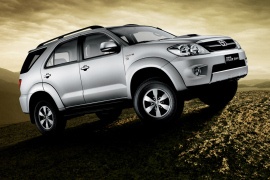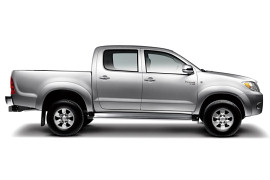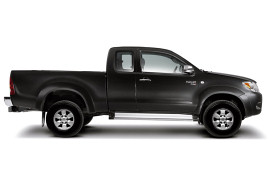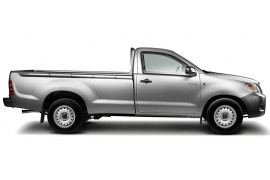TOYOTA Hilux Models/Series Timeline, Specifications & Photos
First production year: 2005
Engines: Diesel, Gasoline
Body style: Truck
The idea of creating an SUV based on a pickup wasn’t new, and Toyota used that recipe to make the Fortuner/SW4 lineup, which was unveiled at the Thailand International Motor Expo in 2004.
The Japanese automaker used different nameplates for its body-on-frame SUV positioned between the Rav4 and the Land Cruiser. However, regardless of how it was called, the Fortuner or the SW4, they relied on the rugged and trustworthy chassis of the seventh generation of the Hilux. Furthermore, it even carried over some of the engines and transmissions from that pickup, but the automaker also decided to install new powerplants that were unavailable for the utilitarian off-roader. As a result, customers knew what they would get and expect from their SUVs, and these vehicles were quite successful in the countries where they were sold. Unfortunately, the North American, European, Australian, and British customers couldn’t get their hands on one since Toyota didn’t sell them there.
At the front, the automaker tried to sweeten the lines of the regular Hilux when it penned the SW4’s fascia. It still featured a black grille that housed the chromed Toyota badge flanked by a pair of headlights that resembled the ones from the Corolla rather than those from the Hilux. Furthermore, the bumper was tall and had an integrated air intake on the lower side, protected by an aluminum skid plate. In addition, customers could opt for a pair of fog lamps.
From its profile, the difference between the SW4 and the Hilux was clear. Up to the B-post, the windshield and the front fenders resembled those from its pickup sibling. However, behind the cabin’s mid-section, it was entirely different. Toyota’s design team created a roof extended behind the rear seats and raked-forward C-posts. In addition, the flared wheel arches adorned by plastic trims created a sporty but off-road-oriented stance for the car. Furthermore, the 2006 Toyota SW4 featured plastic side sills, while a set of chromed side steps was available. Out back, on the upper side of the tailgate, the automaker put a roof spoiler. Toyota also installed broad taillights extended from the quarter panels on the tailgate, enhancing the vehicle’s look.
Inside, customers were greeted by a cabin that tried to look less utilitarian, even though many of its parts were shared with the Toyota Hilux. Fronting the driver was an instrument cluster with a binocular styling where the speedometer took center stage. It was flanked on its left by the rev counter, while on the right cluster were the gauges for the fuel level and coolant temperature. The center stack housed the stereo and the buttons for the HVAC. Toyota offered the Fortuner/SW4 in a few grades, where the lowest ones had a manual transmission and cloth seats, while the top trim level featured a leather-wrapped interior and automatic gearbox. In the back, the reclining and split-folding bench seat provided enough room for three passengers. Thanks to the ladder-frame construction system, the SW4 didn’t have a tall transmission tunnel to limit legroom for the middle-seated occupant.
Under the hood, Toyota introduced the SW4 with a choice of gasoline and turbodiesel engines. Later on, it dropped the spark-ignited version and left only the oil burners on the offer. It also produced the vehicle as an RWD or as a 4x4 affair, the latter being fitted with a two-speed transfer box.
Toyota unveiled the seventh generation of the Hilux nameplate in the summer of 2004, and it was one of the most significant evolutions in the model’s history.
The Japanese automaker introduced the Hilux in its lineup in 1968. At first, it was a humble utility vehicle that could barely fit a three-person couch in its bed. Over the following five generations, the pickup’s dimensions grew from 4.2 to 4.7 meters or 13.8 ft to 15.4 ft, respectively. In the meantime, it evolved from being a rear-wheel drive utility vehicle to becoming a family hauler, excellent for getaway adventures in nature or saving people from remote, difficult-to-access areas. With the seventh generation, the well-known pickup entered a new era, when cabin comfort started to matter more, but without sacrificing the utilitarian aspect of the vehicle. In Europe, the seventh generation of the Hilux was considered the sixth since the first generation, produced between 1968 and 1972, was sold as the Toyota Truck.
Unlike any of its predecessors, the seventh generation of the Hilux featured rounded shapes, which concealed the rugged character of the vehicle. Its headlights were swept back and featured organic shapes with rounded edges and integrated the corner-mounted turn signal lamps. Between them, Toyota placed a redesigned grille featuring a thick horizontal slat where the badge took center stage. Below, the automaker installed a body-colored bumper featuring an additional rectangular air intake flanked by round fog lamps.
From its profile, the 2005 Toyota Hilux double cab boasted its long wheelbase and provided a roomy enough cabin for five adult-sized occupants. Thanks to the high ground clearance and the wide doors, it was suitable for many tasks, including rescue services or as a family vehicle. Toyota made the Hilux in a traditional way, with a body-on-frame structure, which allowed the automaker to use the same ladder frame for more applications. Behind the cabin, but completely separated, the automaker placed a large bed that could be optioned with a sliding cover. It is worth noticing that even if it was a utility vehicle, it still featured body-colored door mirror caps and handles, while other upscale cars didn’t. At the back, the tailgate could be lowered by 90 degrees or even more with the side retainers removed. Underneath the bed, the Hilux carried the spare wheel.
The 2005 Toyota Hilux Double Cab cabin offered something for anyone. For lower grades, the automaker prepared a hard-plastic dashboard featuring a center console with a stereo. On the other end of the scale, the top trim level featured an infotainment system with a touch-sensitive display. The large dials of the HVAC control panel allowed users to turn them with gloved hands. Fronting the driver was a simple and efficient instrument cluster where the speedometer took center stage and was flanked on the left by the rev counter. On the right, the automaker placed the gauges for engine temperature and the fuel level. Between the front passengers, on the center console, Toyota put the gear stick and the lever for the transfer box. The front seats were flat and were available with cloth or vinyl upholstery. At the same time, the bench seat in the back could accommodate three occupants.
Under its skin, the seventh generation of the Hilux featured a double-wishbone front suspension that improved passengers’ comfort but without ruining the vehicle’s well-known off-road abilities. Toyota didn’t bother to provide a wide choice of engines for this model and offered it with just a 2.4-liter turbodiesel that sent its power to the rear or all four wheels via a five-speed manual and a two-speed transfer box.
The seventh generation of the Hilux was unveiled in the summer of 2004 for the 2005 model year, and the automaker offered it in three cab versions, with the Extra Cab sitting in the middle.
Before launching the 2005 Toyota Hilux Extra Cab, the Japanese automaker sold over 12 million units of this nameplate from the previous generations. It was the second best-selling vehicle in the brand’s portfolio after the Corolla. The history of this nameplate began in 1968 when the first generation was developed and produced by Hino Trucks Company, part of the Toyota holding. That model had a six-foot-long (1.8-meter) bed that could barely fit a couch for three. But the automaker learned what customers wanted and needed. As a result, the Hilux has improved in many ways over the following decades. Furthermore, it added a 4x4 system that gave it serious offroad abilities, transforming the vehicle into one that could deliver food and supplies in frozen or deserted areas. But unlike its previous generations, this one came with more features and amenities and a more comfortable suspension that transformed it into a vehicle suitable for the entire family, especially in the Double Cab shape. The Extra Cab, on the other hand, was made for those who didn’t need the rear seats on a daily basis but could use a more extended loading area. In Europe, the seventh generation of the Hilux was considered the sixth since the first generation, produced between 1968 and 1972, was sold as the Toyota Truck.
At the front, the Extra Cab version was available in more trim levels than its four-door sibling. Furthermore, the new headlights impressed customers with their organic shape featuring rounded edges and integrated turn signals on their outer sides. Between them, Toyota placed a broad grille crossed by a thick horizontal slat that sported the brand’s badge in the middle. In the lowest grade, the 2005 Toyota Hilux Extended Cab had black bumpers, while body-painted ones were standard from the second grade up. Both of them sported a rectangular air intake on the lower side, and a set of round fog lamps was available.
From its profile, the 2005 Toyota Hilux Extra Cab revealed its rounded shapes and shaved corners, which made it look less rugged. Furthermore, those fitted with the 4x4 system boasted a higher ground clearance than those that sent their power to the rear wheels only. Surprisingly, the automaker didn’t consider extending the doors for easier ingress and egress to the rear cabin area, albeit it considered installing tilt-forward front seats. This version also had a more extended loading area. At the back, the tailgate could be lowered at a 90-degree angle or even more if the side retainers were removed. Under the bed, behind the rear axle, the automaker installed the spare wheel.
Inside, the hard-plastic dashboard was the only option available, albeit there were some significant differences in terms of equipment. For the base model, the 2005 Toyota Hilux Extra Cab came with a stereo on the center stack. Underneath it, the automaker placed the large dials for the HVAC system that could be operated with gloved hands. A pair of small storage compartments flanked it. Fronting the driver was a clean instrument cluster with a three-dial arrangement where the speedometer took center stage. It was flanked on the left by the tachometer and on the right by the fuel and temperature gauges. The center console housed the gear stick and the available lever for the transfer box. Customers could enjoy the front seats designed for easy access and exit, with minimal side bolstered areas. In the back, the two jump seats were cramped but usable for short distances or in an emergency.
Depending on the market, the 2005 Toyota Hilux Extra Cab was available with either a 4x4 or a 4x2 drive system. Both versions were fitted with a five-speed manual gearbox, and only the former had a two-speed transfer box. A locking rear differential was also available. Under the hood, Toyota installed only one engine version, a 2.4-liter turbodiesel.
This was the workhorse of the Hilux family for decades, and the seventh generation, unveiled in 2005, proved once again that it was built to endure hard jobs even with poor or minimal maintenance.
When the Japanese automaker made the first generation of the Hilux in 1968, it assigned the project to the Hino Truck company, which Toyota owned. The result was a humble, albeit perfectly adapted, vehicle for those times. Even if it could barely fit a three-person couch in its 1.8-meter (six feet) bed, it sold well. That version was available with a two-door cabin where three people could sit. It was also marketed as the Toyota Truck. As a result, in some continents, the seventh generation of the Hilux was also known as the sixth. Fast forward to 2004, when the automaker unveiled the 2005 Hilux, the new model significantly improved over its predecessor. While it still was a body-on-frame construction, the pickup was available in three cab versions. At the bottom of the range was the single-cab, which was built as a utility vehicle only. However, it was still available with features that made the users’ lives better.
At the front, the 2005 Toyota Hilux Single Cab had a different look, depending on the grade. The lowest trim level had black bumpers, while the upper ones featured body-colored ones. However, both versions sported the same organic-shaped headlights with rounded edges and swept-back design, integrating the turn-signal lamps on the outer edges.
Unlike the other two versions, the 2005 Toyota Hilux Single Cab was available exclusively with a 4x2 system, which resulted in a lower ground clearance, similar to any other sedan on the market. The bodywork featured flared wheel arches on both axles, a steep windshield, and a short roof. Behind it, the automaker placed the longest bed in the 2005 Toyota Hilux family. Thanks to its 2.3-meter (7.6-ft) long bed, it could accommodate more than a three-person couch. It was also suitable for carrying heavy items, such as glass, thanks to its one-ton (2,204 lbs) maximum load rating. Behind, the tailgate could be lowered at 90 degrees or more if the metallic limiters from the sides were removed.
Inside, the hard-plastic dashboard accommodated a center stack where the HVAC controls were installed. The stereo and the AC were optional. In front of the driver, Toyota installed an easy-to-read and understand instrument panel where the large speedometer took center stage. It was flanked by the tachometer on the left and by the fuel and temperature gauges on the right. The automaker offered the car with cloth or vinyl upholstery, both very suitable for daily, hard-working activities.
Under the hood, the 2005 Toyota Hilux Single Cab had a 2.4-liter turbodiesel engine that sent the power to the rear wheels only via a five-speed manual gearbox. The front double-wishbone suspension provided more comfort for those in the cabin. At the same time, the automaker installed a heavy-duty axle with leaf springs in the back.



